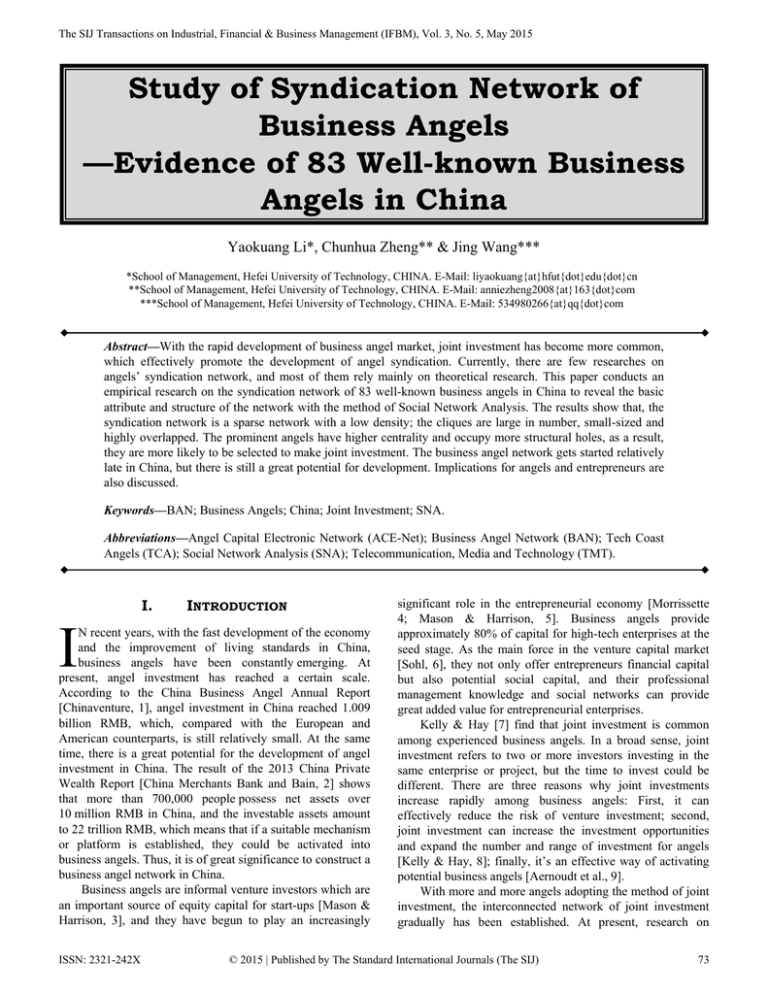Document 14545003
advertisement

The SIJ Transactions on Industrial, Financial & Business Management (IFBM), Vol. 3, No. 5, May 2015
Study of Syndication Network of
Business Angels
—Evidence of 83 Well-known Business
Angels in China
Yaokuang Li*, Chunhua Zheng** & Jing Wang***
*School of Management, Hefei University of Technology, CHINA. E-Mail: liyaokuang{at}hfut{dot}edu{dot}cn
**School of Management, Hefei University of Technology, CHINA. E-Mail: anniezheng2008{at}163{dot}com
***School of Management, Hefei University of Technology, CHINA. E-Mail: 534980266{at}qq{dot}com
Abstract—With the rapid development of business angel market, joint investment has become more common,
which effectively promote the development of angel syndication. Currently, there are few researches on
angels’ syndication network, and most of them rely mainly on theoretical research. This paper conducts an
empirical research on the syndication network of 83 well-known business angels in China to reveal the basic
attribute and structure of the network with the method of Social Network Analysis. The results show that, the
syndication network is a sparse network with a low density; the cliques are large in number, small-sized and
highly overlapped. The prominent angels have higher centrality and occupy more structural holes, as a result,
they are more likely to be selected to make joint investment. The business angel network gets started relatively
late in China, but there is still a great potential for development. Implications for angels and entrepreneurs are
also discussed.
Keywords—BAN; Business Angels; China; Joint Investment; SNA.
Abbreviations—Angel Capital Electronic Network (ACE-Net); Business Angel Network (BAN); Tech Coast
Angels (TCA); Social Network Analysis (SNA); Telecommunication, Media and Technology (TMT).
I.
I
INTRODUCTION
N recent years, with the fast development of the economy
and the improvement of living standards in China,
business angels have been constantly emerging. At
present, angel investment has reached a certain scale.
According to the China Business Angel Annual Report
[Chinaventure, 1], angel investment in China reached 1.009
billion RMB, which, compared with the European and
American counterparts, is still relatively small. At the same
time, there is a great potential for the development of angel
investment in China. The result of the 2013 China Private
Wealth Report [China Merchants Bank and Bain, 2] shows
that more than 700,000 people possess net assets over
10 million RMB in China, and the investable assets amount
to 22 trillion RMB, which means that if a suitable mechanism
or platform is established, they could be activated into
business angels. Thus, it is of great significance to construct a
business angel network in China.
Business angels are informal venture investors which are
an important source of equity capital for start-ups [Mason &
Harrison, 3], and they have begun to play an increasingly
ISSN: 2321-242X
significant role in the entrepreneurial economy [Morrissette
4; Mason & Harrison, 5]. Business angels provide
approximately 80% of capital for high-tech enterprises at the
seed stage. As the main force in the venture capital market
[Sohl, 6], they not only offer entrepreneurs financial capital
but also potential social capital, and their professional
management knowledge and social networks can provide
great added value for entrepreneurial enterprises.
Kelly & Hay [7] find that joint investment is common
among experienced business angels. In a broad sense, joint
investment refers to two or more investors investing in the
same enterprise or project, but the time to invest could be
different. There are three reasons why joint investments
increase rapidly among business angels: First, it can
effectively reduce the risk of venture investment; second,
joint investment can increase the investment opportunities
and expand the number and range of investment for angels
[Kelly & Hay, 8]; finally, it’s an effective way of activating
potential business angels [Aernoudt et al., 9].
With more and more angels adopting the method of joint
investment, the interconnected network of joint investment
gradually has been established. At present, research on
© 2015 | Published by The Standard International Journals (The SIJ)
73
The SIJ Transactions on Industrial, Financial & Business Management (IFBM), Vol. 3, No. 5, May 2015
angels’ syndication network are quite few, and most rely
mainly on theoretical research, lacking empirical study. This
paper uses a sample of 83 well-known Chinese business
angels from an entrepreneurial magazine in China. This study
will provide some relevant suggestions for the construction of
the BANs in China through analyzing the basic attribute,
internal structure, centrality and structural holes of the
network.
II.
LITERATURE REVIEW
In the United States, relevant departments and civil
organizations launched a series of activities to create the
Business Angel Network (BAN), with the aim of solving the
matching problem between business angels and entrepreneurs
and to reduce search costs. There are two types of BAN in
America, one is a nonprofit network, such as the Angel
Capital Electronic Network (ACE-Net), and the other is a
commercial network, like Tech Coast Angels (TCA) in
California. Acs & Tarpley [10] found that ACE – Net had
provided a national internet database to bridge financing gaps
for rapid developed enterprises. TCA is composed of
investors in Los Angeles, Orange and San Diego, who made
joint investment across the state come true [Payne &
Macarty, 11].
In Europe, the BAN plays an intermediary role in the
informal investment market. Since 1998, the European
Commission has launched a famous 3-year plan to promote
business angel network creation. The plan has achieved great
results, according to the statistics, there being 298 BANs in
Europe in the middle of 2008. Like BANs in America, the
European BANs can be created by private or government
entities [Mason & Harrison, 12], and the difference is that the
former usually invests in the later stage of the project, while
the BANs created by government are more inclined to invest
in newly-established firms.
Lange et al., [13] relied on the analyses of over 40
identified best practice angel networks in the U.S. and Europe
to make a systematic study of the newest and most innovative
practices in angel networks. They concluded that the
evolution of the BANs are divided into three phases: the
traditional network, entrepreneur-centric networks and
investor-centric networks. How effective are BANs?
Collewaert et al., [14] stated that BANs could improve
startup debt acquisition ability and reduce the influence of
asymmetric information between startup and business angels.
But Zu Knyphausen-Aufs & Westphal [15] found that most
BANs didn’t reach their expected goals. On the contrary,
BANs become a barrier instead of an intermediary between
business angels and entrepreneurs.
In conclusion, much work has been done in the study of
BANs, mainly concentrating on two aspects: the type and
operation mode of BANs. But until now, no empirical study
has analyzed the basic attributes and architectural feature of
BANs. This paper will study the syndication network of 83
well-known business angels in China to reveal the basic
ISSN: 2321-242X
attribute and structure of the network using the method of
Social Network Analysis (SNA).
III.
RESEARCH DESIGN
3.1. Sample
Most angels are hidden populations, and traditional sampling
methods are unable to obtain representative samples and
complete data. This paper takes 83 well-known Chinese
business angels from Entrepreneur magazine in China (No.5,
2012) as the research sample. The 83 well-known business
angels have invested in at least 2 projects, and total
investment is above one million yuan. The samples are
representative because Entrepreneur is one of the most
authoritative and forward-looking magazines in China. The
list of the 83 well-known business angels can be seen in
Table 1.
Table 1: The List of 83 Well-known Business Angels in China
Bing Xie
Jian Ding
Nan Lv
Xipei Jiang
Bo Feng
Nanchun Jiang
Xu Zhao
Ni Yang
Xuefan Qiu
Boquan He
Jiang Wang
Jiangtao
Shun
Jiarong Xu
Qi Ji
Xueqian Du
Boren Zheng
Jiaxi Li
Qiang Wang
Yi Shu
Jiong Wu
Qingfeng Chen
Yinchu Wang
Jun Lei
Qinghua Hong
Fan Bao
Kaifu Li
Qingyuan He
Fangming Zhu
Feng Deng
Feng Wang
Keyi Chen
Lei Yang
Leilei Wang
Songyi Zhang
Tanping Lv
Tao Tang
Ying Wu
Yongqiang
Qian
Yuan Wang
Yueqiao Bao
Yunlei Yun
Feng Yu
Lijie Wang
Xiang Li
Zhe Zhou
Fuyuan Lin
Lin Chen
Xiangning Zhang
Zhengdong Ni
Gang Mai
Liqing Zeng
Xiangyang Yang
Zhenyu Yang
Hai Wu
Luhua Rao
Xiao Wang
Zhenzhang Li
Hao Lu
Maodong Xu
Xiaofeng Chen
Zhiguo Li
Haozhi Chen
Hongjia Gong
Hongwei Shun
Mike Cai
Min Fan
Min Zhu
Xiaolin Zhong
Xiaoping Xu
Xiaosong Liu
Zhishuo Liu
Zhu Li
Zhujie Li
Hongwei Zhou
Molin Zhong
Xiaoying Liu
Ziwang Xu
Bo Liu
Changgui
Zhao
Daihong Lin
Ji Zhang
Manzi Xue
Xingsheng Zhang
Source: Entrepreneur, 2012, 5:102-104
3.2. Method
Social network is referred to as a set of social actors and the
relationships between them. SNA analyzes the relationship
between network members to study the structure and attribute
features of the network. SNA has become a cross-disciplinary
subject with applications in diverse fields such as sociology,
economics, psychology, and has produced many valuable
research results. The 83 well-known business angels in China
objectively formed a social network due to their joint
investments. Correspondingly, this paper will analyze it from
the perspective of social network.
© 2015 | Published by The Standard International Journals (The SIJ)
74
The SIJ Transactions on Industrial, Financial & Business Management (IFBM), Vol. 3, No. 5, May 2015
3.3. Data Source and Processing
Secondary data sources such as media reports, historical data,
and internet materials are an important means of sociological
quantitative research. This method has been used in many
studies because of its virtues, such as low cost and easier
access [Jun Liu, 16]. We collect relevant information on 83
well-known business angels by using this method. There are
three main data sources for this paper: Entrepreneur
magazines, Baidu Encyclopedia and news report. In order to
examine the validity and dependability of the data, we make a
field research on the China Youth Angel Association to gain
the raw data of some members of 83 well-known business
angels. The results basically accord with the collected data,
which indicates that the secondary data in this paper is
feasible.
This paper collected information on 689 investment
projects made by the 83 well-known business angels, among
which 77 were joint investment projects. We build an 83*77
order matrix based on the collected data, in which, the row
data refers to business angel and the column data refers to
investment projects. In this 0-1 matrix, 0 means the business
angel didn’t invest in the project, 1 means that the business
angel invested in the project. We draw a syndication network
graph with UCINET as shown in Figure 1. The circles
represent business angels and blocks represent projects.
Figure 1: Syndication Network of 83 Well-known Business Angels in China (2-mode)
3.4. Fundamental Analysis
The 83 well-known business angels prefer to invest in
projects in the field of TMT (Telecommunication, Media and
Technology). The choice of investment industry depends on
the characteristics of the industry, its prospects, and business
angels’ preferences as well. Most of them choose a field
where they have gained a lot of experience, and some angels
even publicly expressed that they only want to invest in
projects in a specific industry.
The 83 well-known business angels also preferred to
invest in projects located in Beijing, Shanghai and
Guangzhou. Investment allocation not only reflects the
development of innovation and entrepreneurship in this city,
but also reflects the angels’ preference for the city. The 83
well-known business angels like to invest in the residence or
cities which have well developed economies and technology.
The hotspot cities have strong entrepreneurial atmosphere
ISSN: 2321-242X
and abundant investment channels, attracting more venture
capital, which is advantageous to startup project financing.
The business angels tended to cooperate with people who
share similar investment preferences. For example, Gang Mai
and Jiarong Xu who are among 83 well-known business
angels both prefer to invest in the internet industry, so they
have the chance to cooperate with each other several times,
Docin web is one of their representative joint investments.
Exchange of experience becomes a major channel to avoid
risk and reduce losses in the investment, which accounts for
the reason some angels will turn first to experienced persons
who have worked with them before. Results show that it’s
relatively common for colleagues to invest in the same
project. For example, Yongqiang Qian, Qiang Wang and
Xiaoping Xu were the founders of the New Oriental; later,
they jointly invested in China’s popular matchmaker’s
network, Jiayuan.com.
© 2015 | Published by The Standard International Journals (The SIJ)
75
The SIJ Transactions on Industrial, Financial & Business Management (IFBM), Vol. 3, No. 5, May 2015
IV.
SYNDICATION NETWORK ANALYSIS
4.1. Basic Attributes Analysis
This paper transforms 2-mode data to 1-mode data with
UCINET [Borgatti et al., 17] as figure 2 shows. Results show
that, 61 of the 83 well-known business angels have joint
investments. The value between every two business angels
represents the times they have ever cooperated. For example,
the number 4 between Qiang Wang and Xiaoping Xu
illustrates that they have made joint investments 4 times.
Table 2 shows that most angels are lacking sustainable
cooperation; only 13.76% angels have invested together more
than one time.
Figure 2: Syndication Network of 83 Well-known Business Angels in China (1-mode)
Table 2: The Times of Cooperation Analysis
The times of
1
2
3
4
5
6
cooperation
The number of
188
18
4
6
0
2
the ties
Percentage
86.24 8.26 1.83 2.75 0.00 0.92
(%)
Total
218
100
Network density is measured by comparing the actual
number of ties with the potential number that would occur if
the members in the network connected with each other. The
density of the syndication network is 0.04, which infers the
network is sparse with only 4 % links. Network distance
refers to the shortest path between two actors, and the
average distance is measured by counting the number of links
that if any two members of the network would connect. The
syndication network ranges from 1 to 8 in distance, the
average distance being 3.457. Distance-based cohesion
Compactness is an index measuring the cohesiveness of the
network, ranging from 0 to 1, in which larger values indicate
greater cohesiveness, and vice versa. The clustering
coefficient is an important element reflecting the degree of
aggregation of the network nodes; this syndication network
has a high clustering coefficient, thus indicating a high
probability of condensing subgroups.
ISSN: 2321-242X
Table 3: The Value of Basic Attributes Analysis
Basic attribute
Density
Shortest distance (among reachable pairs)
Longest distance (among reachable pairs)
Average distance (among reachable pairs)
Distance-based cohesion (Compactness)
Clustering coefficient
Value
0.040
1.000
8.000
3.457
0.168
0.685
4.2. Internal Structure Analysis
A clique is a subset of actors who have direct connections
with one another and no additional network member can be
added who also has direct connections with everyone in the
subset [Vilpponen et al., 18]. The members in the same clique
are more closely linked with each other than outsiders. The
data display shows that there are 26 cliques in the syndication
network, but the size is small, with each clique containing 3
or 4 members. Normative networks tend to lack large cliques
that are often found in utilitarian organizations [Tichy, 19].
The more members a clique has, the harder it is to come to an
investment agreement.
Everett & Borgatti [20] has mentioned that the number of
cliques that an actor belongs to could be seen as a new
measure of centrality -- clique overlap centrality. This paper
© 2015 | Published by The Standard International Journals (The SIJ)
76
The SIJ Transactions on Industrial, Financial & Business Management (IFBM), Vol. 3, No. 5, May 2015
found that there exist 20 members in two or more cliques.
These 20 members act as bridges to effectively promote the
flow of resources and information between cliques. In
particular, Xiaoping Xu is a member of 11 cliques, who keeps
in touch with most of the cliques and plays a leading role in
the network. The cliques are not mutually isolated but
contacted with each other because of the existence of
overlapping clique members, as shown in Figure 3.
Examining clique and clique overlap allows us to gain a
deeper insight into the cohesive subgroup structure of the
syndication network of 83 well-known business angels.
Figure 3: Clique-by-Clique Overlap
From the perspective of internal structure, the
syndication network is composed of cliques that link with
each other through weak connections. Each clique is a small
social network; they are in a different position and play a
Angels
Xiaoping Xu
Jiarong Xu
Bo Feng
Jun Lei
Xueqian Du
Gang Mai
Xiao Wang
Nanchun Jiang
Qiang Wang
Keyi Chen
Degree
Betweenness
4.3. Centrality Analysis
Network position significantly influences the extent of
members to obtain resources and information. Centrality is
one focus of social network analysis, reflecting members’
position and influence. Members with high centrality have
more direct access to others. On the contrary, members with
low centrality are inactive and generally on the periphery of
the network [Wasserman et al., 21]. A number of studies take
centrality as a key measure to reflect the distribution of
relationships and to identify key members in the network.
This paper identifies key members based on indexes of
point centrality and betweenness centrality. Point centrality,
representing an angel’s gregariousness, is calculated by
summing the weights of all edges directly connected to an
individual’s node [Opsahl et al., 22]. The member with a high
point centrality value reflects that he or she is active in the
network and has the largest number of ties to other business
angels. A member with high degree centrality is often the
focal individual to whom others go for advice or others
consider a friend from whom they can gain support.
Betweenness centrality quantifies the number of times a node
acts as a bridge along the shortest path between two other
nodes. It’s often used to measure the ability of an actor to
control resource flow in the network.
Table 4: Top 20 in the Point Centrality Analysis and Betweenness Centrality Analysis
Degree
Angels
Degree
Angels
Betweenness
Angels
21
Jiong Wu
8
Xiaoping Xu
628.256
Xu Zhao
14
Feng Deng
7
Xiao Wang
406.862
Bo Feng
12
Ni Yang
7
Jiong Wu
308.235
Yinchu Wang
10
Liqing Zeng
6
Nanchun Jiang
189.745
Min Fan
10
Jian Ding
6
Jun Lei
189.187
Jiarong Xu
9
Xu Zhao
6
Keyi Chen
185.899
Jian Ding
9
Maodong Xu
6
Feng Deng
160.667
Hongwei Zhou
9
Min Fan
5
Lijie Wang
159.000
Maodong Xu
9
Xiaolin Zhong
5
Ni Yang
153.271
Zhengdong Ni
8
Zhengdong Ni
5
Liqing Zeng
132.457
Xueqian Du
Mean
3.277
47.301
Table 5: Descriptive Statistics for each Measure
Std Dev
Sum
Variance
3.739
272
13.983
97.194
3926
9446.587
Table 4 shows that there are 17 angels within the top 20
with high values both in point centrality analysis and
betweenness centrality analysis. The 17 angels are obviously
active in the network, and they can control information
effectively. Particularly, Xiaoping Xu has the highest value in
centrality analysis, representing the key member with a
powerful mediating effect to promote interaction in the
network. On the other hand, data in table 4 indicate that
resources in the network are unequally distributed, and the
most angels are on the periphery of the syndication network.
This syndication network is a highly centralized network, for
ISSN: 2321-242X
different role. The members in the same clique generally
share a similar investment philosophy and investment criteria.
The analysis of cliques is helpful to understand the structure
and operation of the syndication network.
Minimum
0
0
Betweenness
120.100
115.749
109.000
108.000
107.471
106.486
88.028
81.165
67.699
62.701
Maximum
21
628.256
a small percentage of angels have a high percentage of
relationships in the network [Chinowsky et al., 23].
4.4. Structural Holes
Structural holes are present in an actor’s network of
relationships when a focal actor is tied to others who are not
themselves connected [Burt, 24]. When it comes to structural
holes, it involves at least three members for A, B, C.
Supposing that A and B are linked, B and C are linked, but A
is not associated with C, we define this as a structural hole
(Burt, 2009). B occupies the position of hole, so he or she has
a better access to information and enjoy comparative
© 2015 | Published by The Standard International Journals (The SIJ)
77
The SIJ Transactions on Industrial, Financial & Business Management (IFBM), Vol. 3, No. 5, May 2015
advantages. In recent years, some empirical studies show that
actors who bridge structural holes have gained prominent
advantages.
Burt calculated structure holes contain four aspects:
effective size, efficiency, constraint and hierarchy. Effective
size is an index to measure the nonredundancy of the
network, calculated by subtracting the redundancy form the
Business Angel
Xiaoping Xu
Nanchun Jiang
Jiong Wu
Ni Yang
Bo Feng
Jun Lei
Maodong Xu
Jian Ding
Keyi Chen
Jiarong Xu
Liqing Zeng
Xiao Wang
Feng Deng
Zhengdong Ni
Xueqian Du
Qiang Wang
Jiang Wang
Xu Zhao
Yongqiang Qian
Hongwei Zhou
Table 6: Top 20 in Effective Size Analysis
Effective Size
Efficiency
10.506
0.657
6.596
0.66
6.396
0.711
5.792
0.724
5.221
0.653
4.741
0.593
4.630
0.661
4.583
0.655
4.092
0.585
3.882
0.485
3.650
0.521
3.641
0.520
3.615
0.516
3.417
0.569
3.328
0.475
3.269
0.467
3.167
0.633
3.100
0.517
2.958
0.592
2.810
0.562
The results show that the members in table 6 are almost
identical to those in table 4, which reflects that people who
occupy more structural holes have higher centrality as well.
It’s necessary to maintain a wealth of structural holes in one’s
network, because the position of a hole has a better access to
information and provides comparative advantages; having
different structural holes will improve the diversity of one’s
personal network. Structural holes, acting as a bridge,
promote the flow of information and bring business angels
from opposite sides of the hole together to make investments.
V.
RESULTS AND DISCUSSIONS
The syndication network is a sparse network, in which the
majority of business angels lack direct contact and
sustainable cooperation, hindering information sharing in the
network. The analysis reflects that angel investment gets
started relatively late in China, the coverage of joint
investment is small, and there is a great potential for
investment exchanges and cooperation among business
angels.
The cliques of the syndication network are large in
number, small-sized and highly overlapped. This shows that
most well-known business angels don’t like to invest in the
same project with too many angels. Members in the same
clique generally share a similar investment philosophy and
criteria. Furthermore, the cliques are not mutually isolated but
contacted with each other because of the existence of
ISSN: 2321-242X
size of the individual network. Efficiency is a relative index;
the efficiency of a point is the ratio of effective size to actual
size. Constraint refers to a member’s ability to utilize and
coordinate the network. Hierarchy measures the centrality of
the member; those with high hierarchy are generally key
members in the network.
Constraint
0.389
0.407
0.457
0.448
0.568
0.601
0.511
0.547
0.568
0.627
0.538
0.627
0.589
0.625
0.587
0.633
0.632
0.607
0.634
0.654
Hierarchy
0.537
0.294
0.341
0.126
0.441
0.491
0.22
0.38
0.333
0.515
0.349
0.455
0.479
0.467
0.353
0.362
0.157
0.343
0.059
0.338
overlapping clique members who act as bridges to effectively
promote the flow of resources and information between
cliques.
A small percentage of angels have a high percentage of
relationships in the network. There is a large difference in the
capacity to access and control resources in the syndication
network. Angels with high centrality have more opportunities
to cooperate with other angels, while the members on the
periphery of the network are easily ignored. Cooperation
among key members is emerging to reduce investment risk.
Peripheral members of the syndication network should
actively pursue every opportunity to cooperate with key
members in order to enhance their reputation and access more
high quality investment.
The results also show that business angels who bridge
structural holes in the network gain significant advantages to
initiate the business angel group. Structural holes are
channels for promoting the flow of information, and bringing
together business angels from opposite sides of the hole to
make investments. Angels who occupy structural holes are
likely to increase the diversity of the ego network, so the
information and control advantages of structural holes should
be a competitive advantage for angels.
VI.
IMPLICATIONS AND LIMITATIONS
Based on the above analysis and conclusion, we find that
there is a huge potential for Chinese angels to build
© 2015 | Published by The Standard International Journals (The SIJ)
78
The SIJ Transactions on Industrial, Financial & Business Management (IFBM), Vol. 3, No. 5, May 2015
cooperative relationship through BAN. The 83 well-known
Chinese business angels have rich investment experience and
high social reputation, thus they have greater opportunities to
establish a business angel club or business angel network. We
should ensure that these key members have the opportunity to
play a major role in the establishment of BAN; as such, they
can drive joint investment practices in China. Angels who
lack experience should actively pursue every opportunity to
cooperate with these key members in order to enhance their
reputation and obtain high quality investment opportunities.
At the same time, we should enhance communication
between small angel groups to raise the standard of
information sharing and broaden investment channels. For
entrepreneurs, a better understanding of angel syndication
network can help start-ups to target their fundraising goal.
Entrepreneurs should approach angels selectively and try to
tap into the network of angels to increases the chance of
financing.
Since information collected in this paper is mainly from
the Internet and relevant magazines, it might benefit from
other types of data. Another limitation is that this paper does
not distinguish leading investors from follower investors,
which presents a consideration for future research.
VII.
[8]
[9]
[10]
[11]
[12]
[13]
[14]
ACKNOWLEDGEMENTS
The authors thank the National Natural Science Foundation
of China for the funding that made this study possible
(Funded project: Research on financing from business angels:
theory and application, No. 71072138; Personal and
institutional drivers and the model of financing from business
angel and VC of women owned entrepreneurial firm, No.
71272056).
[15]
[16]
[17]
REFERENCES
[1]
[2]
[3]
[4]
[5]
[6]
[7]
Chinaventure (2014), “China Business Angels Annual Report”,
A Report for Analyzing the Development of Business Angels in
China.
CMBC (China Merchants Bank and Bain) (2013), “China
Private Wealth Report in 2013”, A Report for Analyzing the
Development of Private Wealth and Private Banking in China.
C.M. Mason & R.T. Harrison (1995), “Closing the Regional
Equity Capital Gap: The Role of Informal Venture Capital”,
Small Business Economics, Vol. 7, Pp. 153–172.
S.G. Morrissette (2007), “A Profile of Angel Investors”,
Journal of Private Equity Summer, Pp. 52–67.
C.M. Mason & R.T. Harrison (2000), “The Size of the Informal
Venture Capital Market in the UK”, Journal of Small Business
Economics, Vol. 15, Pp. 137–148.
J.E. Sohl (2003), “The US Angel and Venture Capital Market:
Recent Trends and Developments”, The Journal of Private
Equity, Vol. 6, No. 2, Pp. 7–17.
P. Kelly & M. Hay (2000), “'Deal-Makers': Reputation Attracts
Quality”, Venture Capital: An International Journal of
Entrepreneurial Finance, Vol. 2, No. 3, 183–202.
ISSN: 2321-242X
[18]
[19]
[20]
[21]
[22]
[23]
[24]
P. Kelly & M. Hay (1997), “'Deal-makers': Reputation Attracts
Quality”, Venture Capital: An International Journal of
Entrepreneurial Finance, Vol. 2, No. 3, Pp. 183–202.
R. Aernoudt, A. San José & J. Roure (2007), “Executive
Forum: Public Support for the Business Angel Market in
Europe–A Critical Review”, Venture Capital: An International
Journal of Entrepreneurial Finance, Vol. 9, No. 1, Pp. 71–84.
Z.J. Acs & F.A. Tarpley (1998), “The Angel Capital Electronic
Network (ACE-Net)”, Journal of Banking and Finance Vol.
22, No. 6, Pp. 793–797.
W.H. Payne & M.J. Macarty (2002), “The Anatomy of an
Angel Investing Network: Tech Coast Angels”, Venture
Capital: An International Journal of Entrepreneurial Finance,
Vol. 4, No. 4, Pp. 331–336.
C.M. Mason & R.T. Harrison (2002), “Barriers to Investment
in the Informal Venture Capital Sector”, Journal of
Entrepreneurship & Regional Development, Vol. 14, Pp. 271–
287.
J. Lange, B. Leleux & B. Surlemont (2003), “Angel Networks
for the 21st Century: An Examination of Practices of Leading
Networks in Europe and the US”, The Journal of Private
Equity, Vol. 6, No. 2, Pp. 18–28.
V. Collewaert, S. Manigart & R. Aernoudt (2010),
“Assessment of Government Funding of Business Angel
Networks in Flanders”, Journal of Regional Studies, Vol. 44,
No. 1, Pp. 119–130.
D. Zu Knyphausen-Aufseß & R. Westphal (2008), “Do
Business Angel Networks Deliver Value to Business Angels?”,
Venture Capital: An International Journal of Entrepreneurial
Finance, Vol. 10, No. 2, Pp. 149–169.
Jun Liu (2004), “An Introduction to Social Network Analysis”,
Social Sciences Academic Press.
S.P. Borgatti, M.G. Everett & L.C. Freeman (2002), “Ucinet
for Windows: Software for Social Network Analysis”.
A. Vilpponen, S. Winter & S. Sundqvist (2006), “Electronic
Word-of-Mouth in Online Environments: Exploring Referral
Networks Structure and Adoption Behavior”, Journal of
Interactive Advertising, Vol. 6, No. 2, Pp. 8–77.
N. Tichy (1973), “An Analysis of Clique Formation and
Structure in Organizations”, Journal of Administrative Science
Quarterly, Pp. 194–208.
M.G. Everett & S.P. Borgatti (1998), “Analyzing Clique
Overlap”, Journal of Connections, Vol. 21, No. 1, Pp. 49–61.
Wasserman, Stanley & Joseph Galaskiewicz (1994),
“Advances in Social Network Analysis: Research in the Social
and Behavioral Sciences”, Sage Publications, Vol. 171,
T. Opsahl, F. Agneessens & J. Skvoretz (2010), “Node
Centrality in Weighted Networks: Generalizing Degree and
Shortest Paths”, Journal of Social Networks, Vol. 32, No. 3, Pp.
245–251.
P. Chinowsky, J. Diekmann & V. Galotti (2008), “Social
Network Model of Construction”, Journal of Construction
Engineering and Management, Vol. 134, No. 10, Pp. 804–812.
R.S. Burt (2009), “Structural Holes: The Social Structure of
Competition”, Harvard University Press.
© 2015 | Published by The Standard International Journals (The SIJ)
79







